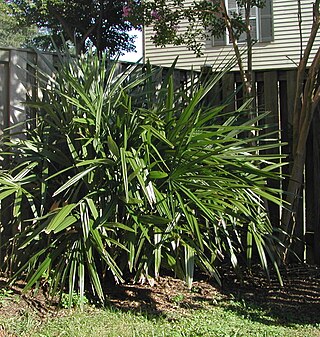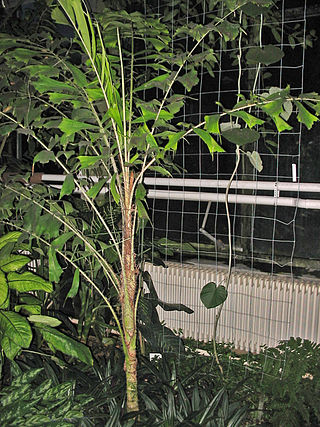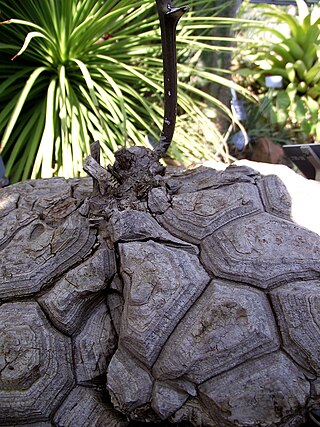
Salacca is a genus of about 20 species of palms native to Southeast Asia and the eastern Himalayas. They are dioecious and pollinated by Curculionidae beetles.

Rhapidophyllum hystrix, the needle palm, is a palm, the sole member of the genus Rhapidophyllum. It is native to coastal margins of the subtropical eastern Gulf and south Atlantic states of the United States. Endemic populations can be found from coastal southeast South Carolina, southward to Florida and west across the coastal plain of Mississippi and southern Alabama. It is one of the most cold-hardy palms in the world, and can be found growing in several areas with warm temperate climates.

Roystonea is a genus of eleven species of monoecious palms, native to the Caribbean Islands, and the adjacent coasts of the United States (Florida), Central America and northern South America. Commonly known as the royal palms, the genus was named after Roy Stone, a U.S. Army engineer. It contains some of the most recognizable and commonly cultivated palms in tropical and subtropical regions.

Copernicia is a genus of palms native to South America and the Greater Antilles. Of the known species and nothospecies (hybrids), 22 of the 27 are endemic to Cuba. They are fan palms, with the leaves with a bare petiole terminating in a rounded fan of numerous leaflets. The species are small to medium-sized trees growing to 5–30 m tall, typically occurring close to streams and rivers in savanna habitats.

Euterpe is a genus of palm trees, containing eight species that are native to Central America and the Yucatan, the West Indies, and South America, from Belize and the Windward Islands southward to Brazil, Peru and Argentina. These palms grow mainly in swamps and floodplains.

Brahea is a genus of palms in the family Arecaceae. They are commonly referred to as hesper palms and are endemic to Mexico and Central America. All Hesper Palms have large, fan-shaped leaves. The generic name honours Danish astronomer Tycho Brahe (1546-1601).

Aiphanes horrida is a palm native to northern South America and Trinidad and Tobago. Aiphanes horrida is a solitary, spiny tree. In the wild it grows 3–10 metres tall tall with a stem diameter of 6–10 centimetres ; cultivated trees may be as much as 15 m (49') tall with a 15 cm (6") diameter. The epicarp and mesocarp of the fruit are rich in carotene and are eaten in Colombia, while the seeds are used to make candles. In parts of the Colombian Llanos endocarps are used to play games.

Dioscorea mexicana, Mexican yam or cabeza de negro is a species of yam in the genus Dioscorea.

Caryota is a genus of palm trees. They are often known as fishtail palms because of the shape of their leaves. There are about 13 species native to Asia, northern Australia, and the South Pacific. One of the more widely known species is Caryota urens, the flowers of which are used to make one type of jaggery, and also to make palm wine. Caryota mitis is native to Indochina, but has become an invasive introduced species in the US state of Florida. They are also one of the few Arecaceae with bipinnate foliage. Many grow in mountainous areas and are adapted to warm mediterranean climates as well as subtropical and tropical climates.

Caryota no is a species of flowering plant in the family Arecaceae. It is endemic to the Island of Borneo. Its specific epithet is from the common name in Malaysian, cajù nó. It is called baroch by the Dayak people of Singhi. The fibers, which are used for fishing lines or woven into baskets, are called talì onus. The extremely hard wood is also used like similar species.

Ceroxylon is a genus of flowering plants in the family Arecaceae, native to the Andes in Venezuela, Colombia, Ecuador, Peru, and Bolivia, known as Andean wax palms.

Chelyocarpus is a genus of small to medium-sized fan palms which are native to northwestern South America. Some are upright trees, while others creep along the ground. Species are used for thatch, to weave hats, stuff pillows and as a source of salt.

Latania, commonly known as latan palm or latania palm, is a genus of flowering plant in the palm tree family, native to the Mascarene Islands in the western Indian Ocean.

Caryota urens is a species of flowering plant in the palm family, native to Sri Lanka, India, Myanmar and Malaysia, where they grow in fields and rainforest clearings, it is regarded as introduced in Cambodia. The epithet urens is Latin for "stinging" alluding to the chemicals in the fruit. Common names in English include solitary fishtail palm, kitul palm, toddy palm, wine palm, sago palm and jaggery palm. Its leaf is used as fishing rod after trimming the branches of the leaf and drying. According to Monier-Williams, it is called moha-karin in Sanskrit. It is one of the sugar palms.

Guihaia is a genus of three species of dioecious palms found in China and Vietnam. Perhaps its most distinctive characteristic is that it is the only palm with palmate leaves that has reduplicate (A-shaped) leaf folds. All other palmate leaves have induplicate (V-shaped) leaf folds. Guihaia lancifolia has undivided leaves.

Caryota obtusa is a species of flowering plant in the palm family from India, Laos and Thailand. The palm is commonly called giant fishtail palm or Thai giant caryota. It can reach 20 meters or more in height and is thus considered a tree. It is monocarpic meaning it flowers once, then dies. Its inflorescence can reach 6 meters or more in length.

The Coryphoideae is one of five subfamilies in the palm family, Arecaceae. It contains all of the genera with palmate leaves, excepting Mauritia, Mauritiella and Lepidocaryum, all of subfamily Calamoideae, tribe Lepidocaryeae, subtribe Mauritiinae. However, all Coryphoid palm leaves have induplicate (V-shaped) leaf folds, while Calamoid palms have reduplicate leaf folds. Pinnate leaves do occur in Coryphoideae, in Phoenix, Arenga, Wallichia and bipinnate in Caryota.

Cyrtostachys renda, also known by the common names red sealing wax palm and lipstick palm, is a palm that is native to Thailand, Malaysia, Sumatra and Borneo in Indonesia. It is the only species of the genus Cyrtostachys that can be found to the west of the Wallace Line, the faunal boundary separating the biogeographic realms of Asia and Wallacea. Cyrtostachys renda's name is derived from several words: the Greek prefix κυρτό- (cyrto-) meaning bent or curved, the Greek word σταχυς (stachys) meaning "an ear of grain", and "renda" a Malayan Aboriginal word for palm, which happens to be homonymous to the Portuguese word "renda," meaning income.

Caryoteae is a tribe in the palm family Arecaceae, distributed across Southeast Asia, from southern India and Sri Lanka east to Vanuatu and northernmost Queensland, Australia. It was long considered a member of subfamily Arecoideae on the basis of its inflorescences, which resemble those of tribe Iriarteeae, and the flowers arranged in triads, which are common across Arecoideae. However, phylogenetic studies based on DNA repeatedly link Caryoteae to subfamily Coryphoideae. Caryoteae do have leaves with induplicate folds, a feature found in most Coryphoid palms, but unlike most Coryphoideae, the leaves are pinnate or bipinnate (Caryota). Phoenix is the only other Coryphoid genus with induplicate, pinnate leaves.

Caryota mitis, known as the clustering fishtail palm or fishtail palm, is a species of palm native to Tropical Asia from India to Java to southern China, now sparingly naturalized in southern Florida and in parts of Africa and Latin America. The species was originally described from Vietnam in 1790. In Florida, it grows in hummocks and in disturbed wooded areas.



















